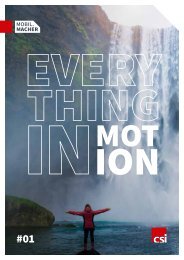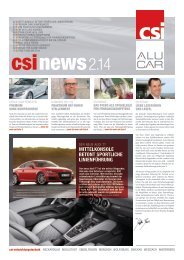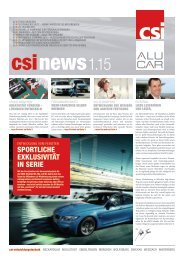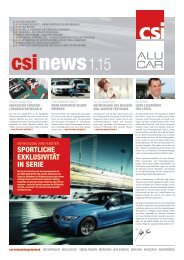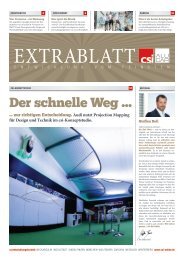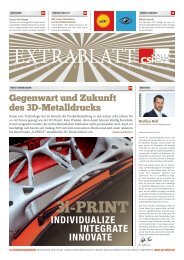csi Newsletter 2022 english
Create successful ePaper yourself
Turn your PDF publications into a flip-book with our unique Google optimized e-Paper software.
18 | ma<strong>csi</strong>_mum | <strong>2022</strong><br />
DOMINIK KAUFMANN AND NILS LANGHANS,<br />
MANAGING DIRECTORS OF THE<br />
KAUFMANN/LANGHANS STRATEGY CONSULTANCY<br />
WHY<br />
TRATEGY<br />
FREQUENT FAILURE AND<br />
HOW A STRATEGIC PROCESS NEEDS<br />
TO PERFORM IN THE DIGITAL AGE<br />
STRATEGY NO LONGER<br />
across the entire organisation, to somehow<br />
PERFORMS AS IT NEEDS TO.<br />
Slow, frustrating, poor results – the<br />
traditional process involving months<br />
of strategic development and subsequent<br />
implementation has never<br />
worked particularly well. However, in<br />
most companies it is standard practice<br />
– with significant consequences.<br />
In the digital age, lost strategy work<br />
increasingly threatens the competitivity<br />
of companies. A rethought strategic<br />
process which produces fast results<br />
through short iterations and, at<br />
the same time, mobilises the overall<br />
organisation may help here.<br />
bring everybody on board and mobilise them<br />
for the new direction. A difficult, if not hopeless<br />
undertaking which frequently stirs up more frustration<br />
and confusion than enthusiasm and clarity.<br />
The result: no result. According to various<br />
studies, between 70 and 90 percent of strategies<br />
fail in their implementation.<br />
DISRUPTION IN THE<br />
AUTOMOTIVE SECTOR IS<br />
IN FULL SWING.<br />
One thing is clear: strategy work according to<br />
the waterfall principle has never worked particularly<br />
well. Yet, in the analogue age, the miserable<br />
efficacy of most strategy processes didn’t<br />
companies no longer need to solve complicated<br />
problems. Now, more and more frequently,<br />
they face complex challenges with fully transparent<br />
routes to solutions. The example of the<br />
automotive and mobility industry makes it particularly<br />
clear how, within a few years, accepted<br />
certainties about value and value creation<br />
were turned on their head. In the shortest time,<br />
new, upcoming players have come to the fore,<br />
while former giants are now foundering. It can<br />
be said with come certainty that disruption is<br />
in full swing in the automotive sector – and in<br />
The mix of the massive acceleration of the digital<br />
age and the increasing complexity of strategic<br />
questioning means that strategy in many<br />
companies is simply no longer doing what it<br />
needs to do: it neither delivers stability and<br />
orientation in tumultuous times, nor does it ensure<br />
sufficient flexibility and adaptability. The<br />
strategy fails where it is most urgently needed.<br />
The solution for this problem is as simple as it<br />
is challenging: companies need to overcome the<br />
deep chasm between strategy development and<br />
strategy implementation to keep pace with the<br />
increasing speed of the digital age. And: they<br />
must completely close the file on consecutive<br />
thinking – first perfect development and then<br />
carry much weight: most other companies pro-<br />
many other sectors too. The ever-faster speed<br />
implementation – and instead unify the devel-<br />
In many organisations, the strategy process<br />
ceeded with a similar level of inefficiency and<br />
with new technology, new business models and<br />
opment and implementation of strategies from<br />
still works in roughly this way: a small number<br />
the problems companies had to solve followed a<br />
new working methods are spreading in the dig-<br />
the ground up. Establishing a continuous strat-<br />
of people sits brooding in a quiet little room<br />
clear cause and effect connection. It was par for<br />
ital age is radically shortening innovation cycles<br />
egy process which produces results in short it-<br />
until finally, after months, white smoke signals<br />
the course not to reach or even mobilise every-<br />
and planning timelines. Nor is there any end in<br />
erations and mobilises the entire organisation is<br />
appear: we have a strategy! However, the pride<br />
one with the strategy. However, things have<br />
sight to the acceleration. The consequence: the<br />
becoming increasingly critical to the success of<br />
in the grand design developed is mixed with a<br />
fundamentally changed over the last decade:<br />
consecutive process from protracted strategy<br />
meeting this requirement.<br />
rumble in the gut: how can we actually imple-<br />
development, subsequent translation into daily<br />
ment it? An attempt is made to roll out the strat-<br />
operations and downstream implementation is<br />
egy developed in a small circle in strict secrecy<br />
simply too slow and too inefficient, and threatens<br />
companies’ competitivity.




